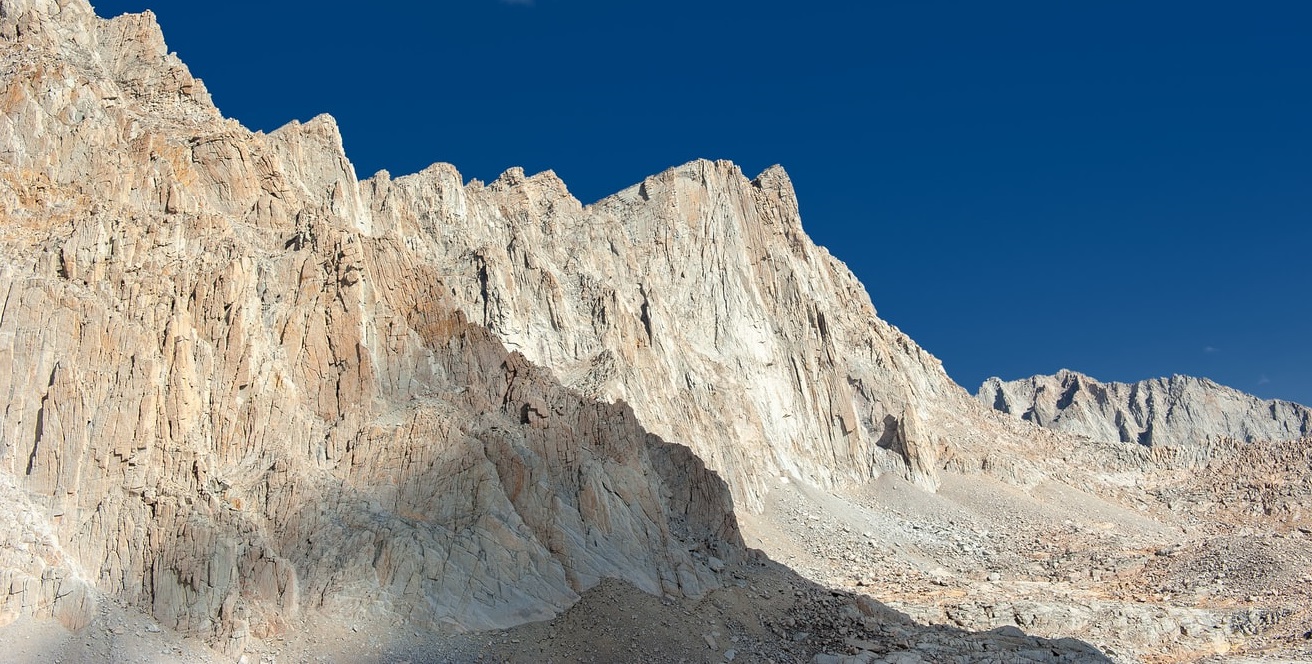Physical Weathering
- Page ID
- 10867
Physical Weathering
Sediment comes from the break down of rocks into smaller, transportable components. This occurs via two processes: physical weathering and chemical weathering. Physical weathering consists of breaking apart rocks and crystals through different processes without changing their chemical composition. The results of physical weathering are smaller components of the same material that is being weathered. There is no change in chemical composition. Physical weathering tends to produce mostly sand-sized sediment and larger grains because most of the fracturing occurs along mineral boundaries. Physical weathering of fine grained or finely crystalline rock can produce abundant very fine grains, but most of the sediment from these rock types consists of rock fragments called lithic clasts. Lithic clasts produced from physical weathering range in size from very fine silts and clays to large boulders and gravel.

Physical weathering, also known as mechanical weathering, works along with chemical weathering to efficiently wear down rocks. Breaking a rock through physical weathering increases the effective surface area in which chemical weathering can occur, and through changing the composition of rocks in chemical weathering, the durability of a rocks surface can decrease allowing for it to be more easily removed by physical processes. From this, we can see that both chemical and physical weathering work together to increase rock erodibilty.
Physical Weathering Processes
There are 6 common ways in which physical weathering happens.
Abrasion:
Abrasion is the process by which clasts are broken through direct collisions with other clasts. Gravity causes abrasion as rocks tumble down a mountainside or cliff. Abrasion also commonly occurs in river beds where clasts tumble along the bottom with the current or on sand dunes where wind causes grains of sand and silt to collide with exposed rock. Rocks can also undergo abrasion within glaciers too, where clasts embedded in ice grind along the rock below. Clasts that undergo abrasion tend to be come more round and smooth. This process is called rounding.
.jpg?revision=1&size=bestfit&width=640&height=480)
Frost Wedging:
Frost wedging occurs in places that have the right temperatures to freeze water and then melt water. This commonly happens in polar regions and mid latitude mountains where sunlight can melt water during the day and refreeze overnight when temperatures drop. Frost wedging is directly related to the fact that as water freezes its volume increases by roughly 9%. Liquid water percolates into existing cracks within a rock. The pressure of expanding ice causes cracks to widen and extend. This processes then repeates as melted water further fills newly formed cracks and freezes. Frost wedging works quickly and results of which can be seen at the bottom of hill-slopes as piles of fragmented rocks.
Biological Activity/Root Wedging:
Weathering processes can happen due to the activity of living organisms. Burrowing animals can break rocks and stir sediments causing physical weathering. Animals that burrow can also bring fresh material to the surface where physical and chemical weathering can work more efficiently. Plant roots in search of nutrients in water grow into fractures. As the roots grow they wedge the rock apart similar to the frost wedging process. This is called root wedging. During root growth, organic acids can form contributing to chemical weathering.
Salt Crystal Growth:
Another expansive force that can break rocks is created by the growth of salt crystals. This process frequently happens near shorelines and in arid regions ie: beaches and deserts. The process begins when water that has dissolved salt in it penetrates cracks in rocks. As the water evaporates, salt crystal begin to form. These crystals expand pushing against existing grains in the rock, this eventually breaks it.
Sheeting:
Sheeting, also known as exfoliation, happens in regions with large masses of igneous rocks. It is caused by the pressure release as overburden rock is eroded away. The process of removing overlying rock is called unloading. As the pressure is released, expansion of the rock causes concentric layers of cracks to form within the igneous body. These layered "sheets" are then broken off by continued weathering.

Thermal Expansion:
When minerals are subjected to different temperature ranges they expand and contract. Rapid temperature fluctuations such as day night cycles can cause individual grains in rocks to expand and contract at different rates. Individual grains can be squeezed from the rock surface or fractures can form to relieve stress. The efficiency of this method is debated by geologist, but no less contributes to physical weathering processes. Climates that experience rapid temperature changes such as deserts display this weathering.
Works Cited
- All notes from Dawn. Sumner, GEL 109 lecture notes
- All images received from Unsplash.com - Free Stock Images

